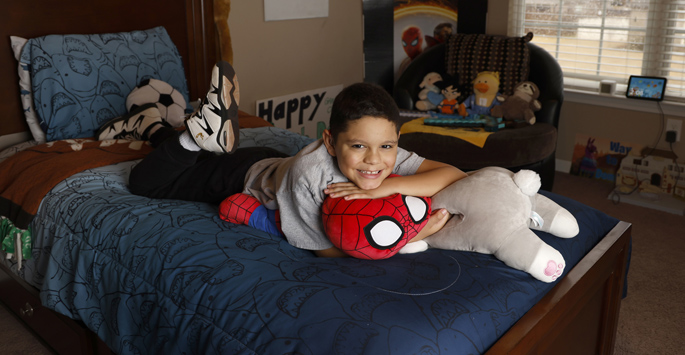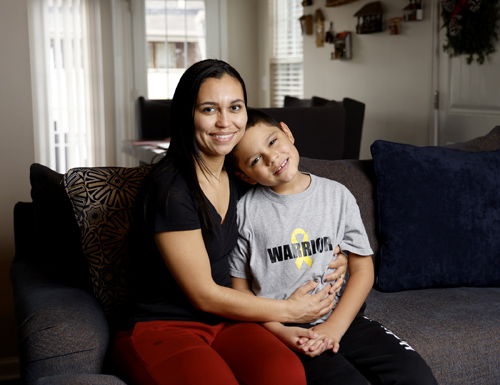
Last year Dominic Gamez was an active 7-year-old boy who loved playing travel soccer.
“He was one of the best players,” said his mother, Lessly. “He was the fastest runner. He was amazing.”
On a Monday last January, he had practices in both martial arts and soccer. When he came home that evening, he complained of pain in his left leg.
Two days later, Lessly noticed it was a little swollen, so she made an appointment with his pediatrician who ordered X-rays.
Within hours, Dominic’s pediatrician said he suspected either an infection or a tumor. A biopsy the next week at Monroe Carell Jr. Children’s Hospital at Vanderbilt confirmed a diagnosis of osteosarcoma, cancer that originates in the bone-forming cells. Treatment requires a combination of chemotherapy and surgery.
“Osteosarcoma is the most common bone cancer seen in children, and is highly malignant,” said Scott Borinstein, MD, PhD, professor of Pediatrics in the Division of Pediatric Hematology/-Oncology at Vanderbilt University Medical Center and director of the Pediatric Sarcoma Program at Monroe Carell. “Eighty percent of all osteosarcomas occur around the knee, like Dominic’s did,” he said.
Dominic had an 8-inch tumor involving two-thirds of his femur, extending from the bottom of the femur near the growth plate (at his knee) to the femur shaft. Growth plates are the biologic machines that make new bone so that we can grow. In addition to removing the cancerous bone, necessary for a cure, often surgery to remove osteosarcoma involves the removal of growth plates, so there are anticipated growth discrepancies, too.
His family was given three choices: amputate; replace the resected femur with a cadaver bone (allograft); or implant a magnetic expandable prosthesis that can be manipulated to grow incrementally as the child grows.
“Amputation was out of the question,” Lessly said. They also ruled out an allograft which must be replaced as the child grows, is more unstable and is more apt to fracture with activity. The family chose the magnetic expandable prosthesis for Dominic, which has been used 17 times at Monroe Carell over the past decade. It requires one surgery to remove the tumor, check the tumor’s margins and insert the implant.

“Of all the options, this gives him the best chance to be active, to be Dominic,” said Dominic’s surgeon, Jennifer Halpern, MD, assistant professor of Orthopaedic Surgery and Rehabilitation. “The expandable femur replacement/-knee replacement is durable, reliable, and it grows with the child.”
After Dominic’s diagnosis and the decision to go with the expandable prosthesis, he had a port placed for chemotherapy, which he received from January through March. In April he had the seven-hour surgery to remove the knee and the femur, and the prosthesis was implanted. A few weeks later he continued his chemotherapy regimen.
For patients who choose the magnetic expandable prosthesis, advanced imaging helps to plan and build their custom implants. MRI scans help to determine the size of the tumor that needs to be removed. CT scans are used to build custom implants that match the patient’s anatomy. The size of the implant also impacts the growth potential of the device. The larger the replacement, the more the implant can be “grown.”
The surgeon writes a prescription for the implant, and it is custom built during the weeks the patient is receiving chemotherapy, pending the surgeon’s approval during the construction process.
Halpern said the magnetic expandable prosthesis is ideal for Dominic because his femur would normally grow more than 4.4 inches over the next eight years. “The combination of a durable implant that allows for weight bearing, with an option for noninvasive periodic expansion, is a powerful tool in limb salvage surgery,” she said.
After the skin has healed following the surgery, the prosthesis can be lengthened 4 mm at a time in the clinic with a special magnetic device that is shipped to Monroe Carell.
It takes about four minutes per millimeter and is painless. “Most patients sit and read a book or look at their phone while the lengthening process occurs,” Halpern said.
Each patient will have a schedule for monitoring leg length and lengthening — generally at six weeks after the surgery and then in three-month intervals.
Lessly said Dominic took a few steps with his walker a few hours after the surgery and with the help of physical therapy, was walking with a walker by the end of June.
Dominic, now 8, is doing well and is adjusting to the fact that it’s not recommended that he play competitive soccer or other high-impact cutting and pivoting sports. Low-impact activities like golf or swimming are ideal, and Lessly said she hopes to get Dominic signed up for a swim team.
“Across the board, we don’t recommend extensive running in a prosthesis of this length, but we typically allow kids to do and try as much as they can,” Halpern said. “The specific concern for Dominic is that he has a very small amount of residual femur left, so that small area is asked to do a lot. Prior to his diagnosis, Dominic had focused on and excelled at competitive soccer. It is hard for anyone to pivot away from the things they love and have done. However, the amazing thing about our patients is that they often open new doors and find something extraordinary — something that fills them, feeds them and sustains the amazing person that they are. We want Dominic to be active, but we also want to minimize the trauma of having major surgeries that can become limb threatening,” she said.
“Kids who have an allograft can’t bear weight for months, and they can’t do a lot of athletic things because their knee joints are unstable. Dominic really hasn’t lost a step. He’s asking to do more and more, and we’ll let him do more and more as we assess if it’s safe. He’s doing a lot, and I’m grateful for that. It’s not easy to reinvent yourself, but I think he’ll be and do something miraculous,” Halpern said.
Lessly said Dominic has become more outgoing over the past year.
“There’s a Dominic before and a Dominic after,” she said. “Before, he was such an introvert. He was very, very shy. He would hide behind me. Now, after all of these doctors and nurses, he’s come out of his shell. He asks questions. ‘Why are you doing this (procedure)? What happens if I run?’ He loves to talk; loves to play; loves anything sports. He’s very loving and caring.”
Lessly said that Dominic met and bonded with two young boys with sarcomas while he was an inpatient at Monroe Carell.
“It was taking one of the little boys way longer than Dominic to walk after his surgery, and Dominic would encourage him. He’d say, ‘You’re a warrior. You can do this. You just have to be determined.’ But also, seeing them made him understand he wasn’t the only one. He wasn’t alone.”












